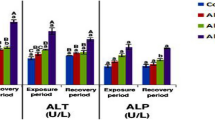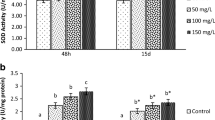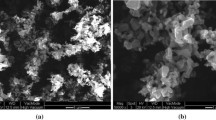Abstract
The aim of this study was to determine the toxic effects of aluminum oxide nanoparticles (Al2O3 NPs) on oxidative stress, stress protein, and genotoxicity parameters in Oreochromis niloticus. Ninety-six-hour LC50 value of Al2O3 NPs was found as 52.4 ppm for O. niloticus. The fish were exposed to 2.6 ppm (5% of the 96-h LC50) and 5.2 ppm (10% of the 96-h LC50) for 3 days and 7 days. Various biochemical parameters, superoxide dismutase (SOD), catalase (CAT), glutathione peroxidase (GPx), glutathione-S-transferase (GST) activities, glutathione (GSH), thiobarbituric acid reactive substance (TBARS), heat shock protein 70 (HSP70; stress protein), and genotoxicity biomarker 8-hydroxy-2-deoxyguanosine (8-OHdG) levels, were determined. Results showed that antioxidant enzymes were significantly decreased in SOD, CAT, and GPx enzyme activity, but GST enzyme activity was significantly increased in 7 days. The oxidative stress parameters, GSH levels, were significantly decreased while 8-OHdG and TBARS levels were increased in 3 and 7 days. HSP70 levels were decreased in the concentrations of Al2O3 NPs and exposure times. Our results showed that as a result of changes in oxidative stress parameters, stress protein, and genotoxicity parameters, O. niloticus liver tissue is highly sensitive and toxic to aluminum oxide nanoparticle exposure.


Similar content being viewed by others
References
Rotello VM (2003) Nanoparticles: building blocks for nanotechnology. 1st ed Springer New York
Murali M, Suganthi P, Athif P, Bukhari AS, Mohamed HS, Basu H, Singhal RK (2017) Histological alterations in the hepatic tissues of Al2O3 nanoparticles exposed freshwater fish Oreochromis mossambicus. J Trace Elem Med Biol 44:125–131
DeFriend KA, Wiesner MR, Barron AR (2003) Alumina and aluminate ultrafiltration membranes derived from alumina nanoparticles. J Membr Sci 224:11–28
Keller AA, McFerran S, Lazareva A, Suh S (2013) Global life-cycle emissions of engineered nanomaterials. J Nano Part Res 15:1692–1709
Moghimi SM, Hunter AC, Murray JC (2005) Nanomedicine: current status and future prospects. FASEB J 19:311–330
Zhang L, Gu F, Chan J, Wang A et al (2007) Nanoparticles in medicine: therapeutic applications and developments. Clin Pharmacol Ther 83:761–769
Blaise C, Gagné F, Ferard JF (2008) Ecotoxicity of selected nano-materials to aquatic organisms. Environ Toxicol 23:591–598
Abdel-Khalek AA (2016) Comparative evaluation of genotoxic effects induced by CuO bulk and nano-particles in Nile tilapia, Oreochromis niloticus. Water Air Soil Pollut 227:35
Prabhakar PV, Reddy UA, Singh SP, Balasubramanyam A, Rahman MF, Indu Kumari S, Mahboob M (2012) Oxidative stress induced by aluminum oxide nanomaterials after acute oral treatment in Wistar rats. J Appl Toxicol 32(6):436–445
Srikanth K, Mahajan A, Pereira E, Duarte AC, Venkateswara Rao J (2015) Aluminium oxide nanoparticles induced morphological changes, cytotoxicity and oxidative stress in Chinook salmon (CHSE-214) cells. J Appl Toxicol 35(10):1133–1140
Benavides M, Fernández-Lodeiro J, Coelho P, Lodeiro C, Diniz MS (2016) Single and combined effects of aluminum (Al2O3) and zinc (ZnO) oxide nanoparticles in a freshwater fish, Carassius auratus. Environ Sci Pollut Res 23(24):24578–24591
Dizdaroglu M, Jaruga P (2012) Mechanisms of free radical-induced damage to DNA Free radical research. 46(4): 382-419
Cazenave J, Ale A, Bacchetta C, Rossi AS (2019) Nanoparticles toxicity in fish models. Curr Pharma Des 25(37):3927–3942
Girilal M, Krishnakumar V, Poornima P, Fayaz AM, Kalaichelvan PT (2015) A comparative study on biologically and chemically synthesized silver nanoparticles induced heat shock proteins on fresh water fish Oreochromis niloticus. Chemosphere 139:461–468
Almeida JA, Diniz YS, Marques SFG, Faine LA, Ribas BO, Burneiko RC, Novelli ELB (2002) The use of the oxidative stres responses as biomarkers in Nile tilapia (Oreochromis niloticus) exposed to in vivo cadmium contamination. Environ Int 27:673–679
Çoğun HY, Firidin G, Aytekin T, Firat O, Firat O, Temiz O, Varkal HS, Kargin F (2017) Acute toxicity of nitrite on some biochemical, hematological and antioxidant parameters in Nile tilapia (Oreochromis niloticus L, 1758). Fresenius Environ Bull 26(2):1712–1719
Tan KW, Sze KZ (2017) Determination of heavy metal concentration in fish species in kampar mining lake, Perak State of Malaysia. Fresenius Environ Bull 26:4202–4207
Vineetha VP, Devika P, Prasitha K, Anilkumar TV (2020) Tinospora cordifolia ameliorated titanium dioxide nanoparticle-induced toxicity via regulating oxidative stress-activated MAPK and NRF2/Keap1 signaling pathways in Nile tilapia (Oreochromis niloticus). Comp Biochem Physi C Toxicol Pharma 240:108908
Vidya PV, Chitra KC (2018) Aluminium oxide nanoparticles induced irreversible alterations in the antioxidant defense system of the fish, Oreochromis mossambicus (Peters, 1852). Euro J Biomed Pharm Scien 5(2):1162–1170
Wang J, Zhu X, Zhang X, Zhao Z, Liu H, George R, Chen Y (2011) Disruption of zebrafish (Danio rerio) reproduction upon chronic exposure to TiO2 nanoparticles Chemosphere 83(4), 461-467
OECD (1992) Guidelines for the testing of chemicals test no 203: fish, acute toxicity test, organization for economic cooperation and development. Paris, France
Finney DJ (1971) Probit analysis. Cambridge University Press New York pp 337
APHA, AWWA, WEF (1998) Standard methods for the examination of water and wastewater. Washington, DC
Bradford MM (1976) A rapid and sensitive method for the quantitation of microgram quantitites of protein utilizing the principle of protein-dye binding. Anal Biochem 72:248–254
McCord JM, Fridovich I (1969) Superoxide dismutase: an enzymatic function for erythrocuprein (hemocuprein). J Biol Chem 244(22):6049–6055
Beutler E (1975) Red cell metabolism, 2nd edn. Grune and Stratton Company, New York, pp 261–265
Beutler E (1984) Red cell metabolism: a manual of biochemical methods 2nd edition Grune and Starton. New York 160s
Habig WH, Pabst MJ, Jakoby WB (1974) Glutathione S-transferases: the first enzymatic step in mercapturic acid formation. J Biochem 25(249):7130–7139
Ohkawa H, Ohishi N, Tagi K (1979) Assay for lipid peroxides in animal tissues by thiobarbituric acid reaction. Anal Chem 95:351–358
De Boeck G, De Wachter B, Vlaeminck A, Blust R (2003) Effect of cortisol treatment and/or sublethal copper exposure on copper uptake and heat shock protein levels in common carp Cyprinus carpio. Environ Toxicol Chem 22:1122–1126
Yin B, Whyatt RM, Perera FP, Randall MC, Cooper TB, Santella RM (1995) Determination of 8-hydroxydeoxyguanosine by an immunoaffinity chromatography-monoclonal antibody-based ELISA. Free Radic Biol Med 18(6):1023–1032
Murali M, Athif P, Suganthi P, He SM, Basu H, Singhal RK (2018) Toxicological effect Of Al2O3 nanoparticles on histoarchitecture of the freshwater fish Oreochromis mossambicus. Environ Toxicol Pharmacol 59:74–81
Li HC, Zhou QF, Wu Y, Fu JJ, Wang T, Jiang GB (2009) Effects of waterborne nano-iron on medaka (Oryzias latipes): antioxidant enzymatic activity, lipid peroxidation and hispathology. Ecotoxicol Environ Saf 72:684–692
Yousef MI, Mutar TF, Kamel MAEN (2019) Hepato-renal toxicity of oral sub-chronic exposure to aluminum oxide and/or zinc oxide nanoparticles in rats. Toxicol Rep 6:336–346
Xiong DW, Fang T, Yu LP, Sima XF, Zhu WT (2011) Effects of nano-scale TiO2, ZnO and their bulk counterparts on zebrafish: acute toxicity, oxidative stress and oxidative damage. Sci Total Environ 409:1444–1452
Lesser MP (2006) Oxidative stress in marine environments: biochemistry and physiological ecology. Annu Rev Physiol 68:253–278
Li HC, Zhou QF, Wu Y, Fu JJ, Wang T, Jiang GB (2009) Effects of waterborne nano-iron on medaka (Oryzias latipes): antioxidant enzymatic activity, lipid peroxidation and hispathology. Ecotoxicol Environ Saf 72:684–692
Wong DWS, Whitaker JR (2002) Catalase handbook of food enzymology. Dekker, New York, USA, p 389
Gomes T, Pinheiro JP, Cancio I, Pereira CG, Cardoso C, Bebianno MJ (2011) Effects of copper nanoparticles exposure in the mussel Mytilus galloprovincialis. Environ Sci Technol 45(21):9356–9362
Zhao X, Wanga S, Wub Y, Youa H, Lva L (2013) Acute ZnO nanoparticles exposure induces developmental toxicity, oxidative stress and DNA damage in embryo-larval zebrafish. Aquat Toxicol 136:49–59
Saddick S, Afifi M, Zinada OAA (2017) Effect of Zinc nanoparticles on oxidative stress-related genes and antioxidant enzymes activity in the brain of Oreochromis niloticus and Tilapia zillii. Saud J Biol Sci 24(7):1672–1678
Alkaladi A (2019) Vitamins E and C ameliorate the oxidative stresses induced by zinc oxide nanoparticles on liver and gills of Oreochromis niloticus. Saud J Biol Sci 26(2):357–362
Rajkumar KS, Kanipandian N, Thirumurugan R (2016) Toxicity assessment on haemotology, biochemical and histopathological alterations of silver nanoparticles-exposed freshwater fish Labeo rohita. Appl Nanosci 6(1):19–29
Abdel-Khalek AA, Badran SR, Marie MAS (2020) The effective adsorbent capacity of rice husk to iron and aluminum oxides nanoparticles using Oreochromis niloticus as a bioindicator: biochemical and oxidative stress biomarkers. Environ Sci Pollut Res:1–13
Abdel-Khalek AA (2015) Antioxidant responses and nuclear deformations in freshwater fish, Oreochromis niloticus, facing degraded environmental conditions. Bull Environ Contam Toxicol 94(6):701–708
Javed M, Ahmad MI, Usmani N, Ahmad M (2017) Multiple biomarker responses (serum biochemistry, oxidative stress, genotoxicity and histopathology) in Channa punctatus exposed to heavy metal loaded waste water. Sci Rep 7:1675–1685
Firidin G (2018) Oxidative stress parameters, induction of lipid peroxidation, and ATPase activity in the liver and kidney of Oreochromis niloticus exposed to lead and mixtures of lead and zinc. Bull Environ Contam Toxicol 100(4):477–484
Zhu S, Oberdörster E, Haasch ML (2006) Toxicity of an engineered nanoparticle (fullerene, C60) in two aquatic species, Daphnia and fathead minnow. Mar Environ Res 62:5–9
Morimoto R, Fodor E (1984) Cell-specific expression of heath shock proteins in chicken reticulocytes and lymphocytes. J Cell Biol 99:1316–1323
Mayer MP, Bukau B (2005) Hsp70 chaperones: cellular functions and molecular mechanism. Cell Mol Life Sci 62:670–684
Khosravi-Katuli K, Shabani A, Paknejad H, Imanpoor MR (2018) Comparative toxicity of silver nanoparticle and ionic silver in juvenile common carp (Cyprinus carpio): accumulation, physiology and histopathology. J Hazard Mater 359:373–381
Hao L, Chen L, Hao J, Zhong N (2013) Bioaccumulation and sub-acute toxicity of zinc oxide nanoparticles in juvenile carp (Cyprinus carpio): a comparative study with its bulk counterparts. Ecotoxicol Environ Saf 91:52–60
Buffet PE, Pan JF, Poirier L, Amiard-Triquet C, Amiard JC, Gaudin P, Mouneyrac C (2013) Biochemical and behavioural responses of the endobenthic bivalve Scrobicularia plana to silver nanoparticles in seawater and microalgal food. Ecotoxicol Environ Saf 89:117–124
Kukreja RC, Kontos MC, Loesser KE, Batra SK, Qian YZ, Gbur CJ Jr, Hess ML (1994) Oxidant stress increases heat shock protein 70 mRNA in isolated perfused rat heart. Amer J Physi Heart Circul Physi 267(6):2213–2219
Xing H, Li S, Wang X, Gao X, Xu S, Wang X (2013) Effects of atrazine and chlorpyrifos on the mRNA levels of HSP70 and HSC70 in the liver, brain, kidney and gill of common carp (Cyprinus carpio L). Chemosphere 90(3):910–916
Fard JK, Jafari S, Eghbal MA (2015) A review of molecular mechanisms involved in toxicity of nanoparticles. Advan Pharma Bull 5(4):447
Lapresta-Fernández A, Fernández A, Blasco J (2012) Nanoecotoxicity effects of engineered silver and gold nanoparticles in aquatic organisms. Tren Analyt Chem 32:40–59
Balasubramanyam A, Sailaja N, Mahboob M, Rahman MF, Misra S, Hussain SM, Grover P (2009) Evaluation of genotoxic effects of oral exposure to aluminum oxide nanomaterials in rat bone marrow. Mut Resear Gen Toxicol Environ Muta 676(1-2):41–47
Tsaousi A, Jones E, Case CP (2010) The in vitro genotoxicity of orthopaedic ceramic (Al2O3) and metal (CoCr alloy) particles. Mut Resear Gen Toxicol Environ Muta 697(1-2):1–9
Di Virgilio AL, Reigosa M, Arnal PM, De Mele MFL (2010) Comparative study of the cytotoxic and genotoxic effects of titanium oxide and aluminium oxide nanoparticles in Chinese hamster ovary (CHO-K1) cells. J Hazard Mater 177(1-3):711–718
Author information
Authors and Affiliations
Corresponding author
Ethics declarations
Ethics Approval
All applicable international, national, and/or institutional guidelines for the care and use of animals were followed.
Conflict of Interest
The authors declare no competing interests.
Additional information
Publisher’s Note
Springer Nature remains neutral with regard to jurisdictional claims in published maps and institutional affiliations.
Rights and permissions
About this article
Cite this article
Temiz, Ö., Kargın, F. Toxicological Impacts on Antioxidant Responses, Stress Protein, and Genotoxicity Parameters of Aluminum Oxide Nanoparticles in the Liver of Oreochromis niloticus. Biol Trace Elem Res 200, 1339–1346 (2022). https://doi.org/10.1007/s12011-021-02723-0
Received:
Accepted:
Published:
Issue Date:
DOI: https://doi.org/10.1007/s12011-021-02723-0




